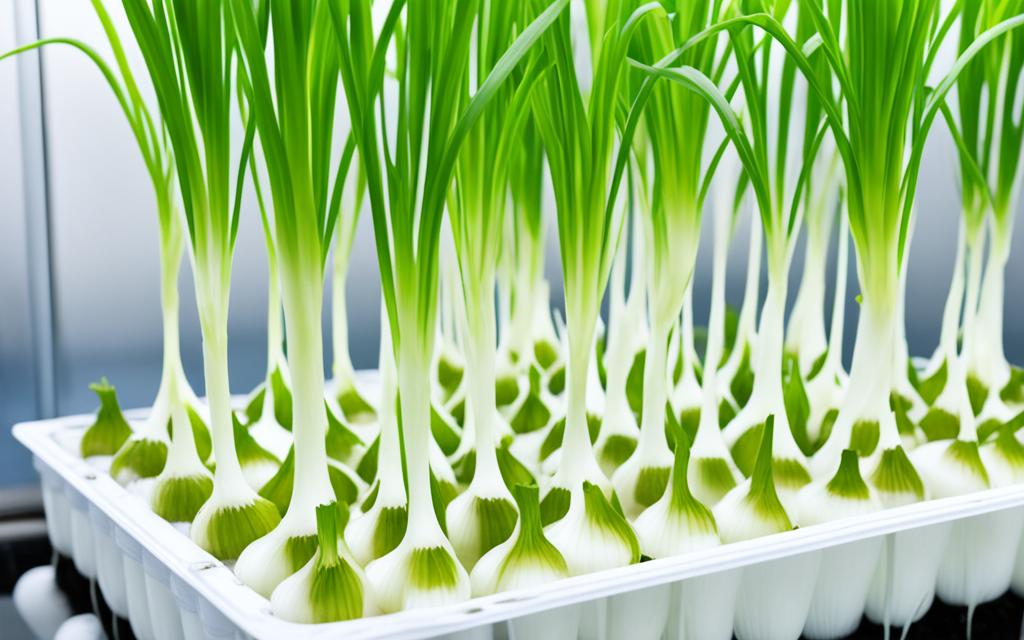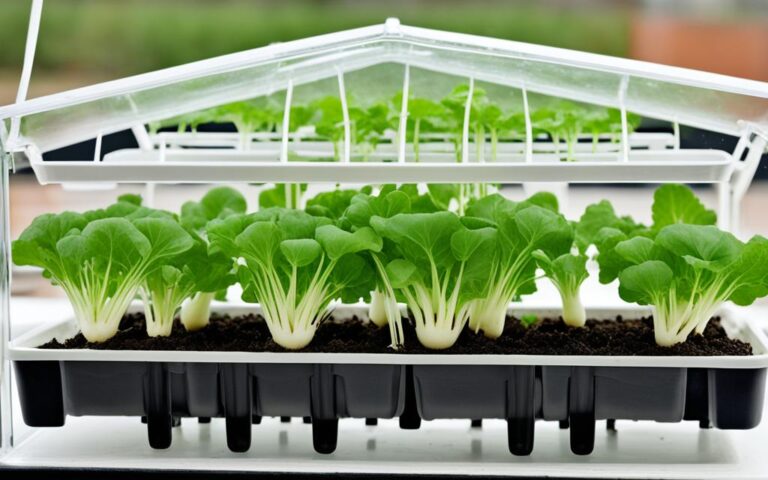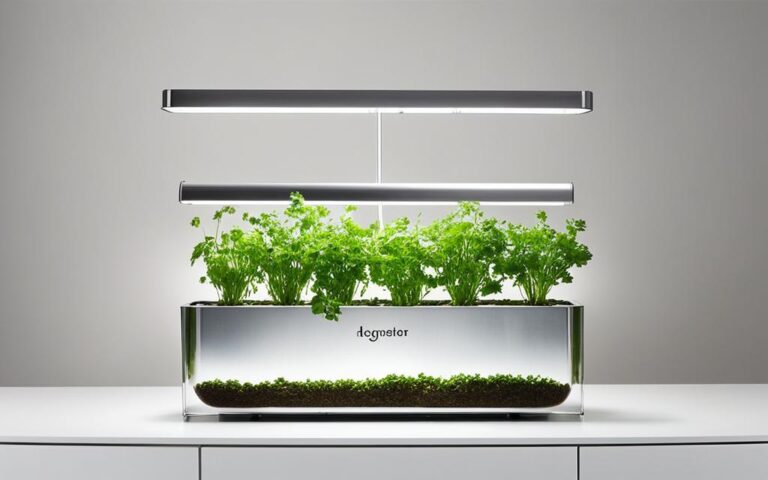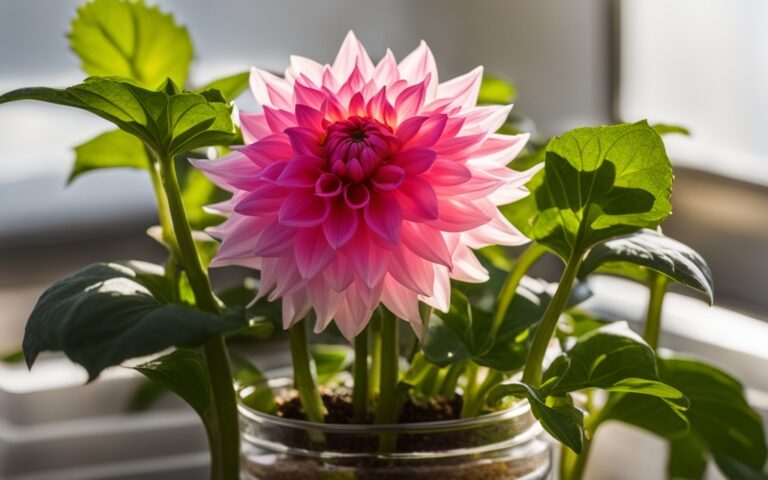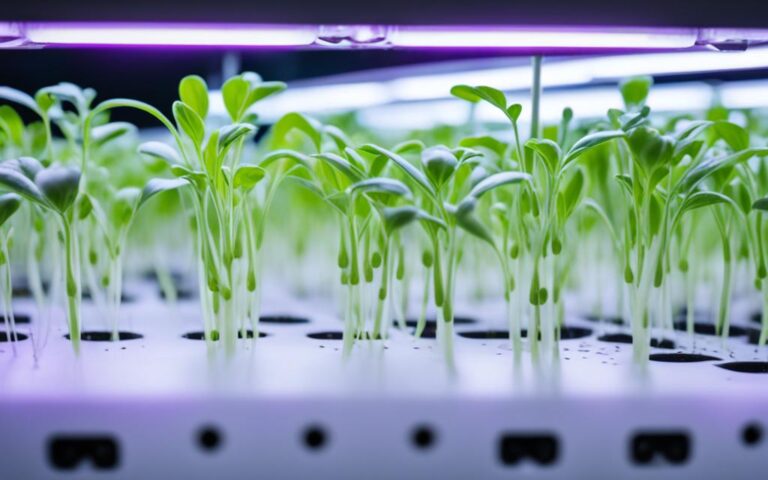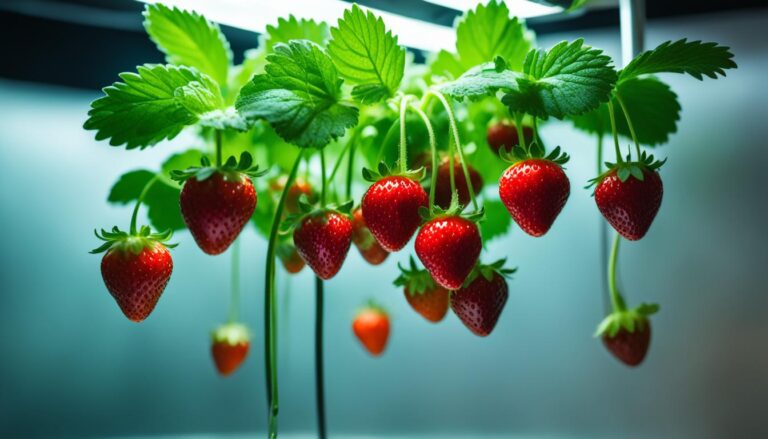Growing Hydroponic Onions: Tips for Success
Hydroponics is changing the way we grow plants, offering a soil-free way to farm. This guide will show you how to grow hydroponic Onions. You’ll learn about the best hydroponic systems and how to get delicious onion layers. By the end, you’ll see why onions in a soil-free, controlled environment agriculture are a great choice for sustainable food production.
Key Takeaways
- Hydroponics uses less water and lets you harvest onions year-round.
- Vertical farming makes the most of small indoor growing space for onion cultivation.
- Picking the right onion varieties and nutrient solutions is key for hydroponic onion success.
- Hydroponic systems prevent soil-borne diseases that can hit traditional onion crops.
- Hydroponic onions often taste better than those grown in soil.
Table of Contents
Benefits of Growing Onions in Hydroponics
Onions are mostly water, making water efficiency key. Hydroponics is great for this, using every drop of water well. It can use up to 10 times less water than traditional farming.
Onions have shallow roots, fitting more plants in a small space. This space optimization lets you grow more onions in less area. You can have continuous harvests all year.
Water Efficiency
Hydroponics cuts down on water waste by recycling the nutrient solution. This reduced water usage is perfect for growing onions in areas with little water.
Space Optimization
Onions don’t need deep roots, so you can pack more plants together in a hydroponic setup. This compact growing way uses space better, letting you grow more onions in a small area.
Year-Round Cultivation
Hydroponics lets you grow onions all year, no matter the season. This means you can always have onions ready to eat, meeting market demands.
“Hydroponic systems enable growing onions all year round regardless of weather conditions, leading to higher yields and faster harvest times compared to traditional methods.”
Setting Up a Hydroponic System for Onions
Growing onions in a hydroponic system needs a well-thought-out setup for their best growth. You must pick the right containers and manage the nutrient solution and environment. Each part is key to getting a good harvest.
Required Materials
To start with hydroponic onions, you’ll need these important items:
- Growing containers with drainage holes for the onion plants
- A nutrient reservoir for the hydroponic solution
- A water pump to move the solution and oxygenate the roots
- Grow lights for 12-16 hours of light daily
Choosing the Right Nutrient Solution
Onions do well in a mix of nitrogen, phosphorus, and potassium. They like more nitrogen for leaf growth. It’s also key to keep the EC between 2.0 and 2.5 when starting to help them take in nutrients.
Ideal pH Levels and Temperature
Getting the pH and temperature right is vital for onions in hydroponics. They like a pH of 5.5 to 6.5 for good nutrient use. The best temperature is 60°F to 75°F (15°C to 24°C) for healthy roots and bulbs.
| Hydroponic System Component | Recommended Specification |
|---|---|
| Nutrient Solution | Balanced NPK ratio, EC range of 2.0-2.5 |
| pH Range | 5.5 to 6.5 |
| Temperature | 60°F to 75°F (15°C to 24°C) |
| Lighting | 12-16 hours of artificial light per day |
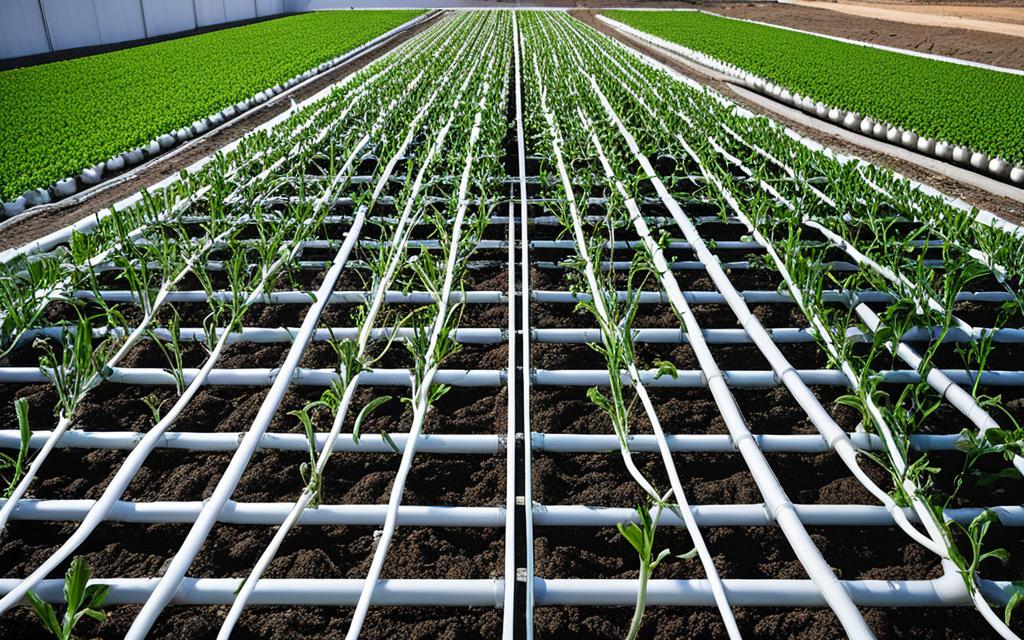
By thinking about these important factors and getting the right parts, you’ll set up a great hydroponic onion system. This can give you a lot of onions all year.
Starting Green Onions Hydroponically
Growing green onions hydroponically offers two main ways: starting from seed or cuttings. Each method has its benefits, depending on your experience and preferences.
Starting From Seed
Choosing high-quality seeds for hydroponic or bunching onions is key when starting from seed. Place the seeds in a container with damp grow media like rock wool or coconut coir. Wait for 10 days until the seedlings have strong roots, then move them to your hydroponic setup.
Starting From Cutting
Starting from cuttings is another option. Cut 6-inch pieces of green onions with healthy roots. Put the roots in water and wait for new growth, which takes 10-14 days. Then, move the cuttings to your hydroponic system.
It doesn’t matter if you start with seeds or cuttings. Make sure the roots get enough water and nutrients for growth. The reservoir should be 6 inches deep, with foam or grow media that supports the plants.
With proper setup and care, you can have a constant supply of fresh green onions at home. Whether from seed or cutting, the goal is to create the best conditions for your hydroponic system.
Growing Green Onions in Different Hydroponic Systems
Green onions, also known as spring onions, can grow well in many hydroponic systems. Each system has its own benefits. They can be grown using the media bed, nutrient film technique (NFT), and deep water culture (DWC) systems.
Media Bed Method
The media bed method uses a grow media like expanded clay pellets to support the plants. This setup lets water flow around the roots, keeping them oxygenated to prevent root rot. For best germination, green onion seeds need a temperature of 65-85°F (18-29°C).
The media bed system can keep this temperature just right.
Nutrient Film Technique (NFT) System
The Nutrient Film Technique (NFT) system sends a thin stream of nutrient-rich water over the roots of the green onions. This method gives the plants constant water and nutrients without fully submerging them. It helps them grow fast.
Green onions in an NFT system do well with a steady flow of water. This flow helps them grow and can make them ready to harvest quicker.
Deep Water Culture
The Deep Water Culture (DWC) system has the plants hanging over a nutrient solution with their roots in the water. It needs good aeration to stop root rot and keep growing conditions perfect. Green onions like a pH level of 6.2 to 6.8, which is easy to keep in a DWC system.
Green onions can be ready to eat in 60-90 days with the right growing conditions. They need 8-10 hours of light a day. By picking the right hydroponic method, growers can get a big harvest of fresh, tasty green onions.
hydroponic Onions
Growing onions hydroponically is a great chance for gardeners and farmers to have onions all year. It uses hydroponic onion growth and soilless onion cultivation. This method is better for water, uses space well, and lets you grow onions all year.
Hydroponics lets you control the growing conditions. This means onions grow better and more than in soil. Short-day onions like Texas Super Sweet and White Garnex do great in hydroponics. They need 10 to 12 hours of light daily.
Green onions grow fast, ready in 21 to 30 days. Other onions like white, red, and sweet take 3 to 90 days to harvest in hydroponics.
For year-round onion production, keeping nutrients and conditions right is key. Onions need a pH of 6.0 to 6.7 and an EC of 1.4 to 1.8. They grow best in temperatures between 12°C (54°F) and 23°C (73°F).
- Increased water efficiency: Hydroponic systems use up to 90% less water compared to traditional soil-based growing methods.
- Space optimization: Hydroponic setups can be designed for vertical growth, allowing for higher yields in limited spaces.
- Year-round production: Hydroponic systems enable growers to cultivate onions consistently throughout the year, regardless of outdoor conditions.
If you’re into hydroponics or new to it, hydroponic onion growth is a great way to try soilless farming. It lets you grow tasty onions all year.
Caring for Hydroponic Onions
Keeping your hydroponic onion plants healthy takes careful attention. It’s important to check the nutrient levels in the solution often and add more as needed. Onions need a lot of nitrogen, so it’s crucial to keep the nutrients balanced for strong growth.
Monitoring Nutrient Levels
Test the nutrient solution regularly to keep your onions healthy. The electrical conductivity (EC) should be between 1.5 and 2.5 mS/cm. This means the minerals are at the right level. Also, keep the pH between 5.5 and 6.5 for best nutrient absorption.
Preventing Common Issues Like Root Rot
Root rot is a big problem for hydroponic onions, often from bad aeration or too much moisture. Use air stones or other devices to keep the solution well-oxygenated. Also, watch the temperature, as warm water can lower oxygen and cause root rot.
Act fast if you see any problems with your onions. They can face many issues. By being proactive and keeping the right conditions, you can keep your onions healthy and productive.
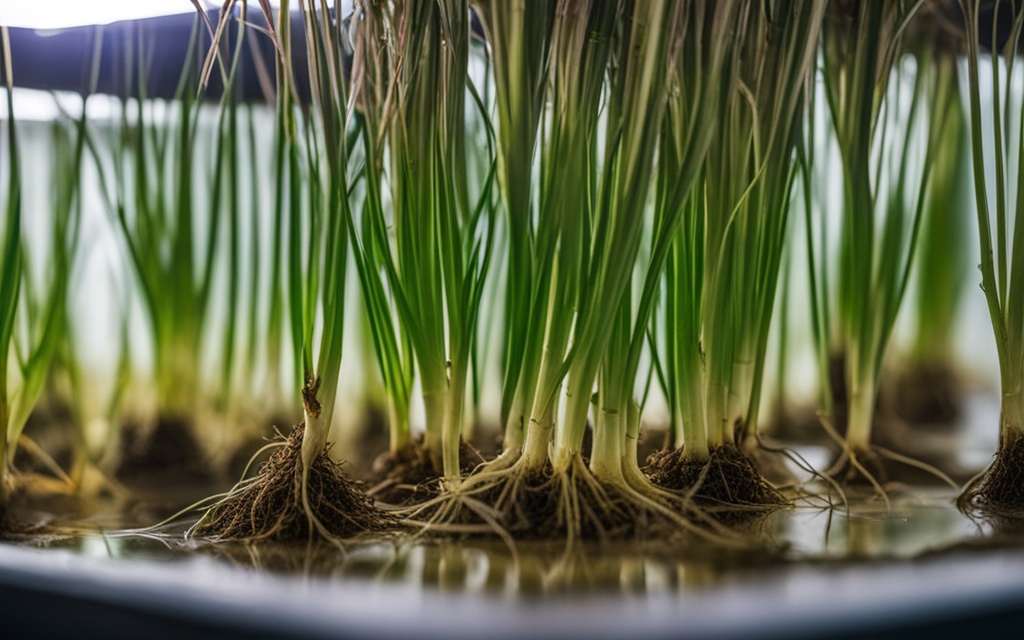
“The key to successful hydroponic onion cultivation is attentive monitoring and proactive management of the growing environment. By staying on top of nutrient levels, pH, and potential issues like root rot, growers can ensure their onions thrive and produce bountiful harvests.”
Necessary Conditions for Growing Hydroponic Onions
To grow hydroponic onions, you need a controlled indoor space. This space should have the right temperature and humidity. Onions grow best in a temperature range of 60-75°F (15-24°C). It’s also important to keep the air moving to avoid mold and rot.
Indoor Growing Space
Choosing the right place to grow hydroponic onions is key. A greenhouse or grow room works well because they control the temperature, humidity, and light. This lets growers create perfect conditions for onions all year, no matter the weather outside.
Hydroponic Grow Media & Nutrients
Onions do well in different hydroponic growing media like perlite, vermiculite, and coconut coir. These materials help with air flow and support the roots. They also make it easy to get nutrients and water to the plants.
A special nutrient mix for alliums, with a pH of 5.8 to 6.3, is also important. This mix gives the onions the right nutrients for strong growth.
| Ideal Conditions for Hydroponic Onion Growth | Recommended Range |
|---|---|
| Temperature | 60-75°F (15-24°C) |
| Humidity | 60-70% |
| pH of Nutrient Solution | 5.8-6.3 |
| Electrical Conductivity (EC) | 1.8-2.2 mS/cm |
| Nutrient Ratio (N-P-K) | 1-2-3 |
By managing the indoor space, the growing media, and the nutrients, growers can make the best conditions for hydroponic onions. This leads to a healthy and productive crop.
Maintaining the Hydroponic Environment & System
Keeping an eye on your hydroponic setup is key for healthy onion plants. Check the pH and electrical conductivity (EC) levels often. Make sure the air flows well and keep the temperature right. Also, keep everything clean and germ-free to stop algae and bacteria from growing.
Monitoring pH and EC Levels
For hydroponic onions, the ideal pH is between 5.5 and 6.5. Testing and adjusting the pH helps your plants get the nutrients they need. The EC level should be 1.2 to 2.0 mS/cm for green onions. Keeping an eye on this ensures your onions grow well.
Controlling Temperature and Aeration
Onions like daytime temperatures of 65-75°F (18-24°C). This temperature is perfect for healthy growth. Good aeration is also important. It keeps oxygen flowing to the roots and stops water from getting stagnant, which can cause root rot.
Cleaning and Sterilizing the System
Cleaning and sterilizing your hydroponic setup is a must. Clean the grow tray or tank, disinfect air and water parts, and replace any old or broken parts. A clean system stops diseases and pests, helping your onions grow strong.
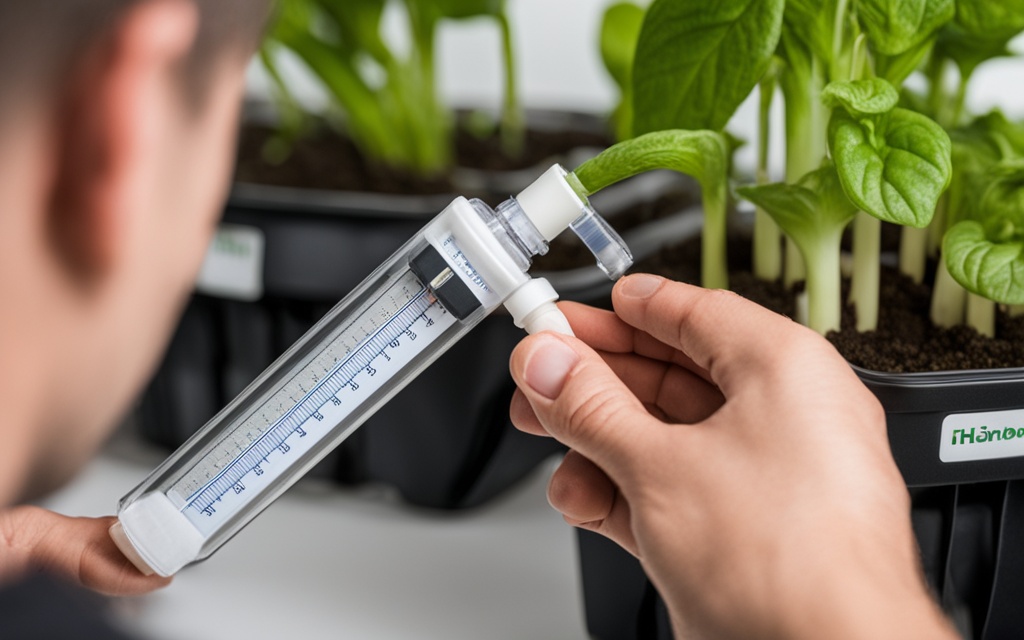
“Consistent monitoring and maintenance of the hydroponic environment are crucial for the ongoing health and productivity of onion plants.”
Harvesting Hydroponic Green Onions
Harvesting hydroponic green onions is easy and straightforward. Wait until the tops reach about 6 inches tall, usually in 20-30 days. Then, cut the greens just above the roots with clean shears or scissors, leaving a bit of bulb. This way, you encourage the plants to grow back and can keep harvesting.
After cutting, wash the onions with cold water to get rid of dirt. This keeps them fresh and tasty. Store them in a cool, moist place to keep them crisp.
Harvesting Methods
- Cut the green onion tops about 1-2 inches above the roots, leaving some bulb.
- Rinse the onions in cold water to clean them.
- Dry the onions with a clean paper towel or cloth.
- Keep the onions in the fridge in a plastic bag or airtight container to stay fresh.
Post-Harvest Handling
- Don’t let harvested onions sit in direct sunlight or heat, as they’ll wilt and lose crispness.
- Keep onions in the fridge in a humid place to make them last longer.
- Think about using a hydroponic system with humidity control for the best storage conditions.
| Hydroponic Growing Conditions | Optimal Harvesting Timeframe |
|---|---|
| 6-9 hours of full sun, 60-75°F temperature, pH 6-6.5, EC 1.8-2 | 20-30 days after planting |
Follow these tips for harvesting and storing to keep your hydroponic green onions fresh and tasty for your recipes.
“Hydroponic farming saves water and uses much less water than traditional farming methods.”
Storing Green Onions
Storing green onions right is key to keeping them fresh and tasty. Here are some tips to help you store your hydroponic green onions well:
Refrigerating them is the best way to keep green onions fresh. Put them in a bag that you can seal or a container without air. Keep them in the crisper drawer of your fridge. Try to keep the temperature at 32°F and the humidity high. This stops the onions from drying out.
You can also store green onions by wrapping them in a damp paper towel. Then, put them in a bag or container that lets air in. This keeps the onions moist and fresh for a longer time.
- Check the onions often and throw away any that are wilted or damaged. This keeps the rest from going bad too soon.
- Try regrowing green onions by planting the white parts with roots in soil. This way, you can keep getting fresh onions.
- Freezing is another way to keep green onions. Wash, dry, and chop them first. Then, spread them on a baking sheet lined with parchment paper. Put them in an airtight container in the freezer for up to 6 months.
Using the right storage methods, keeping them in the fridge, and controlling the humidity are important. They help your hydroponic green onions stay fresh and tasty for a long time. By following these tips, you can make the most of your hydroponic gardening. Enjoy your homegrown produce for longer.
| Storage Method | Humidity Level | Temperature | Shelf Life |
|---|---|---|---|
| Refrigerator | High | 32°F | 7-10 days |
| Wrapped in damp paper towel | Moderate | Refrigerator | 5-7 days |
| Frozen | Low | Freezer | 6 months |
“Proper storage is the key to enjoying the freshness and flavor of your homegrown hydroponic green onions for as long as possible.”
Comparing Hydroponic Onion Growth to Traditional Soil Growth
Hydroponics has changed how we grow onions, offering big benefits over old soil methods. It uses a controlled environment and gives plants exactly what they need. This leads to more onions and faster growth.
Yield Comparisons
Hydroponic onions grow more per square foot than those in soil. They can fit more plants in a small space because they don’t need soil. This means more onions in less area.
Growth Rate Differences
Hydroponic onions grow faster than traditional ones. They get water and nutrients easily, which helps them mature quicker. This means more harvests throughout the year, making growing onions more efficient.
| Parameter | Hydroponic Onions | Traditional Soil-Based Onions |
|---|---|---|
| Yield per square foot | Higher | Lower |
| Growth Rate | Faster | Slower |
| Harvest Frequency | More Frequent | Less Frequent |
| Water Efficiency | Higher | Lower |
| Pest and Disease Control | Easier | More Challenging |
Hydroponic onions grow compactly and mature fast, offering big benefits. They’re a great choice for growers wanting to increase their yields and meet the demand for onions.
Tips for Success
Growing hydroponic onions needs careful attention but offers great rewards. Here are some tips to help your hydroponic onion garden do well:
- Monitor and Adjust pH and Nutrient Levels – Check the pH and nutrient levels often. Adjust them to keep the solution at 6.5-7 pH and balanced minerals.
- Provide Adequate Aeration – Make sure your hydroponic system gets enough air. This prevents root rot and other problems from poor air flow.
- Maintain Optimal Temperatures – Keep the area where onions grow between 65-75°F. This is the best temperature for their growth and health.
- Time Pruning and Harvesting Correctly – Cut and pick your onions at the right times. This helps them grow healthy and increases your harvest.
- Address Issues Promptly – Watch for pests, diseases, or other problems. Fix them quickly to keep your onions healthy.
Follow these tips for growing hydroponic onions, and you’ll have a great harvest, no matter the growing conditions.
| Onion Cultivation Tips | Details |
|---|---|
| Recommended Onion Varieties | Shallots and large storage onions |
| Ideal pH Range for Nutrient Solution | 6.5 – 7 |
| Optimal Temperature Range | 65 – 75°F |
| Nutrient Solution Change Frequency | Every 2-3 weeks |
| Recommended pH Level | Aim for around 6.8 |
| pH Monitoring Frequency | Weekly |
| Nutrient Level Checking Interval | Every 2-4 weeks |
| Nutrient Solution Half-Change Interval | Every 2-3 weeks |
By using these tips and best practices, you’ll grow a thriving hydroponic onion crop. Remember, keep an eye on things, maintain regularly, and fix problems fast for success.
“Hydroponic onions can be a rewarding and space-efficient addition to any indoor or outdoor growing setup. With the right knowledge and attention, you can enjoy a bountiful harvest year-round.”
Troubleshooting Common Problems
Growing hydroponic onions can be rewarding, but you must be ready for problems. Knowing the common issues helps you keep your crop healthy and thriving.
Dealing with Fungal and Bacterial Infections
Fuzzy white mold can show up due to high humidity. To fix this, boost air flow, cut out sick leaves or bulbs, and change the nutrient water often. Bacterial or fungal root rot is another issue. Remove sick plants, clean the system, and add good bacteria to the water to solve it.
Addressing Nutrient Imbalances
Nutrient problems can be tough for hydroponic onion growers. Keep an eye on your nutrient levels and adjust them as needed. Hard water can cause calcium deficiency, while soft water makes it easier to adjust nutrients.
Keep the pH between 5.8 and 6.2 for best nutrient uptake. Check the Electrical Conductivity (EC) or TDS to spot nutrient imbalances.
Preventing Pests and Diseases
Even in controlled systems, pests and diseases can happen. Check your onions for pests or diseases often and act fast. A clean, well-oxygenated system and beneficial organisms help keep pests away.
Understanding and solving common hydroponic onion problems like root rot, nutrient issues, and pests keeps your growing conditions optimal. With patience and a problem-solving attitude, you can enjoy the perks of hydroponic onion growing.
Conclusion
Growing onions hydroponically brings many benefits for gardeners, farmers, and those who care about the planet. It uses less water and makes the most of space. You can grow onions all year without soil.
With the right setup and care, growing onions hydroponically can be very rewarding. You’ll get fresh, tasty onions regularly. It’s a great way to make the most of your space and help the environment.
If you’re new or experienced in hydroponics, exploring this method is a smart move. It helps you produce more onions with less effort. You’ll use fewer resources and support sustainable farming.
When starting with hydroponic onion growing, keep an eye on the nutrients, pH, and temperature. This ensures your onions grow strong and healthy. With the right approach, you can fully enjoy the benefits of this innovative way to grow onions.
